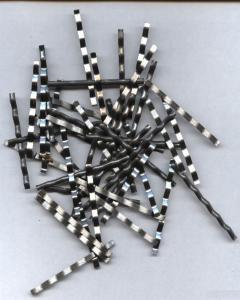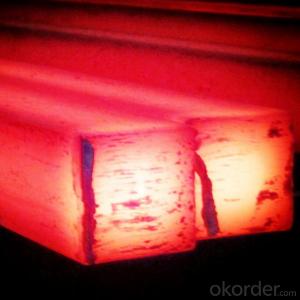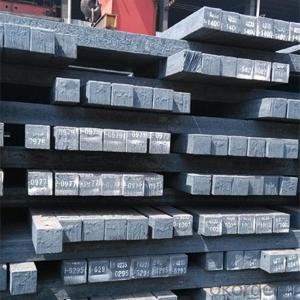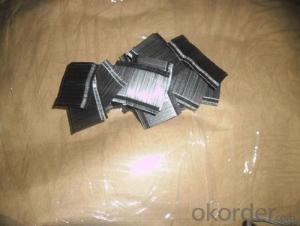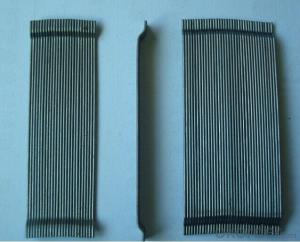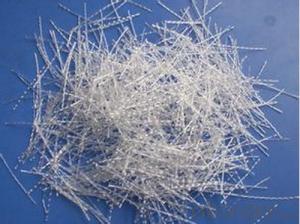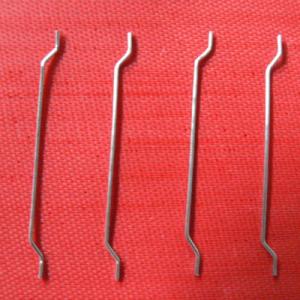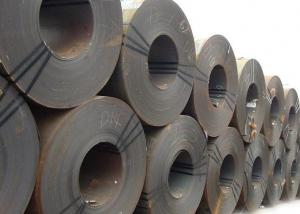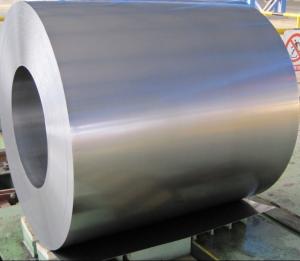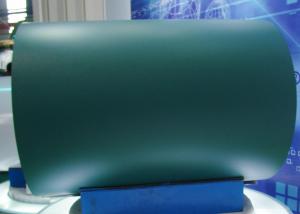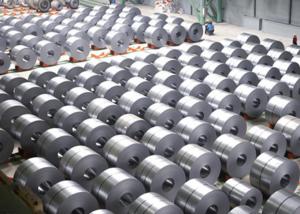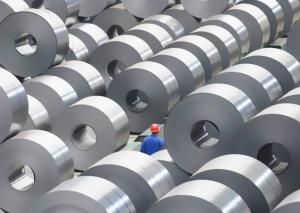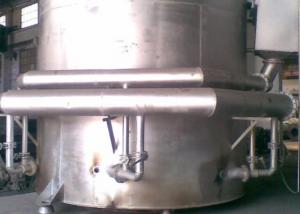Steel Fiber For Concrete
- Loading Port:
- Guangzhou Port
- Payment Terms:
- TT or L/C
- Min Order Qty:
- 5 Tons m.t.
- Supply Capability:
- 50000000 Ton Per Year m.t./month
OKorder Service Pledge
OKorder Financial Service
You Might Also Like
Introduction of Steel Fiber for Concrete:
The Steel Fiber for Concrete uses high-quality low-carbon steel wire, they are high-performance steel fiber, with the characteristics of the high tensile strength, good toughness, etc. The product is widely used for homestic construction,such as buildings ,roads, bridges,airport runny.tunnel ,culvert,inner lining of underground construction,port,pier,and ocean project,etc.
Data Sheet of Steel Fiber for Concrete:
DIA (mm) | Length (mm) | Tensile Strength (MP) |
1 | 60 | ≥1000 |
1 | 50 | ≥1000 |
0.9 | 60 | ≥1000 |
0.9 | 50 | ≥1000 |
0.75 | 60 | ≥1000 |
0.75 | 45 | ≥1000 |
0.75 | 35 | ≥1000 |
0.55 | 30 | ≥1000 |
0.5 | 30 | ≥1000 |
0.5 | 25 | ≥1000 |
0.4 | 25 | ≥1000 |
Economic benefits of steel fiber:
A. Replace of rebar mesh
B. Reduce concrete volume
C.Save construction time and cost
D.Reduce excavation volume
E.Available for jointless floor.
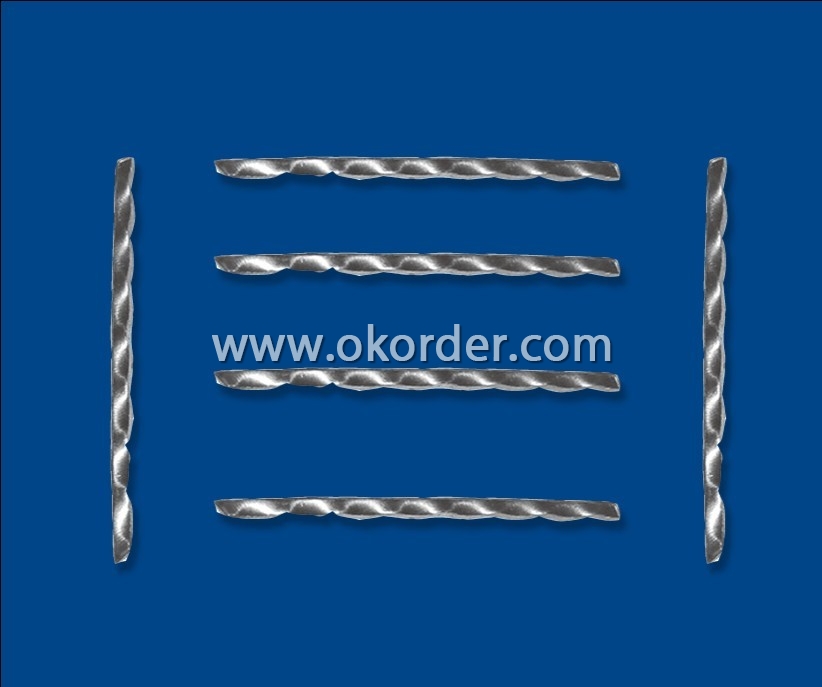
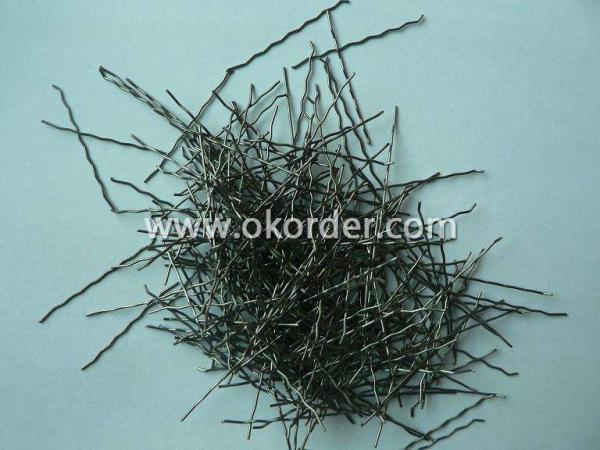
- Q: How are steel products used in the manufacturing of appliances and consumer goods?
- Steel products are widely used in the manufacturing of appliances and consumer goods due to their durability, strength, and versatility. Steel is commonly used to make the frames, casings, and components of appliances like refrigerators, ovens, washing machines, and dishwashers. It provides the necessary stability and structural integrity to support and protect the internal components. Additionally, steel is used in consumer goods such as kitchenware, cutlery, and tools due to its resistance to corrosion and its ability to maintain a sharp edge. Overall, steel plays a crucial role in ensuring the quality and longevity of appliances and consumer goods.
- Q: What are the different grades of steel and their respective applications?
- There are several grades of steel, each with unique properties and applications. Some common grades include carbon steel, which is widely used in construction and manufacturing; stainless steel, which is resistant to corrosion and commonly used in kitchen appliances and medical equipment; tool steel, which is known for its high hardness and used in cutting tools; and alloy steel, which contains different elements to enhance specific properties and is used in automotive and aerospace industries.
- Q: How are steel products used in the construction of theme-based science discovery centers?
- Steel products are commonly used in the construction of theme-based science discovery centers for various purposes. Steel is strong, durable, and versatile, making it an ideal material for creating the framework and structural elements of these buildings. It is used to construct the framework of the building, including columns, beams, and trusses, which provide support and stability. Steel is also used in the construction of stairs, escalators, and elevators, ensuring safe and efficient vertical transportation within the center. Additionally, steel is used in the fabrication of roofing systems, wall panels, and facade elements, providing weather resistance and aesthetic appeal. Overall, steel products play a crucial role in the construction of theme-based science discovery centers, contributing to their durability, safety, and architectural design.
- Q: What are the different methods of joining steel components together?
- There are several methods of joining steel components together. Some common methods include welding, bolting, riveting, adhesive bonding, and soldering. Welding involves melting and fusing the steel components together using heat, while bolting involves using bolts and nuts to secure the components. Riveting involves using rivets to join the components by deforming and clinching them. Adhesive bonding uses specialized adhesives to bond the components together, while soldering involves melting a filler metal to join the components. Each method has its advantages and limitations, depending on factors such as the application, strength requirements, and ease of disassembly.
- Q: What are the applications of steel forgings?
- Steel forgings have a wide range of applications in various industries, including automotive, aerospace, construction, and oil and gas. They are commonly used for manufacturing components that require high strength, durability, and resistance to wear and tear. Some specific applications include crankshafts, gears, axles, connecting rods, turbine blades, and structural components in buildings and bridges.
- Q: How is steel used in the manufacturing of machinery and equipment?
- Steel is commonly used in the manufacturing of machinery and equipment due to its strength, durability, and versatility. It is used to construct the structural framework of machines, as well as components such as gears, shafts, and bearings. Its ability to withstand high temperatures, corrosion, and heavy loads makes it ideal for manufacturing equipment that requires strength and reliability. Additionally, steel can be easily shaped, welded, and machined, allowing for the production of complex machinery and equipment.
- Q: How are steel gratings used in industrial flooring?
- Steel gratings are used in industrial flooring to provide a strong and durable surface that can withstand heavy loads, prevent slipping, and allow for the drainage of liquids and debris. They are commonly used in factories, warehouses, and outdoor areas where a robust flooring solution is required.
- Q: How are steel profiles used in the construction of underground tunnels?
- Steel profiles are commonly used in the construction of underground tunnels as they provide structural support and reinforcement. These profiles are used to create the tunnel lining, which helps to prevent the collapse of the surrounding soil or rock. Additionally, steel profiles can also be used as tunnel ribs or arches, distributing the load and ensuring stability. Overall, steel profiles play a crucial role in enhancing the strength and longevity of underground tunnels.
- Q: How does steel compare to other materials like aluminum or wood?
- Steel is a highly durable and strong material that offers significant advantages compared to materials like aluminum or wood. Its superior strength allows for the construction of larger and sturdier structures, making it ideal for applications where structural integrity is crucial, such as in high-rise buildings and bridges. Additionally, steel's resistance to corrosion and fire makes it a safer and more long-lasting option. Compared to aluminum, steel is generally less expensive and has a higher weight-bearing capacity. While wood has its own unique aesthetic appeal and is renewable, steel surpasses it in terms of strength, durability, and resistance to environmental factors.
- Q: How do steel products contribute to the construction of theme-based culinary experience centers?
- Steel products contribute to the construction of theme-based culinary experience centers by providing structural support, durability, and design flexibility. Steel beams and columns are used to create the framework of the building, ensuring its stability and safety. Steel roofing and cladding materials offer protection against harsh weather conditions, while steel doors and windows provide security and aesthetic appeal. Additionally, steel allows for innovative architectural designs, enabling the creation of unique and eye-catching culinary spaces that enhance the overall theme and experience for visitors.
1. Manufacturer Overview
| Location | Hunan, China |
| Year Established | 1989 |
| Annual Output Value | Above US$ 10 Million |
| Main Markets | North America; South America; Eastern Europe; Southeast Asia; Africa; Oceania; Mid East; Eastern Asia; Western Europe; Central America; |
| Company Certifications | ISO 9001:2000 |
2. Manufacturer Certificates
| a) Certification Name | |
| Range | |
| Reference | |
| Validity Period |
3. Manufacturer Capability
| a) Trade Capacity | |
| Nearest Port | Guangzhou Port |
| Export Percentage | 41% - 50% |
| No.of Employees in Trade Department | Above 10 People |
| Language Spoken: | English; Chinese; |
| b) Factory Information | |
| Factory Size: | Above 20,000 square meters |
| No. of Production Lines | Above 10 |
| Contract Manufacturing | Design Service Offered; Buyer Label Offered |
| Product Price Range | High; Average |
Send your message to us
Steel Fiber For Concrete
- Loading Port:
- Guangzhou Port
- Payment Terms:
- TT or L/C
- Min Order Qty:
- 5 Tons m.t.
- Supply Capability:
- 50000000 Ton Per Year m.t./month
OKorder Service Pledge
OKorder Financial Service
Similar products
Hot products
Hot Searches
Related keywords

